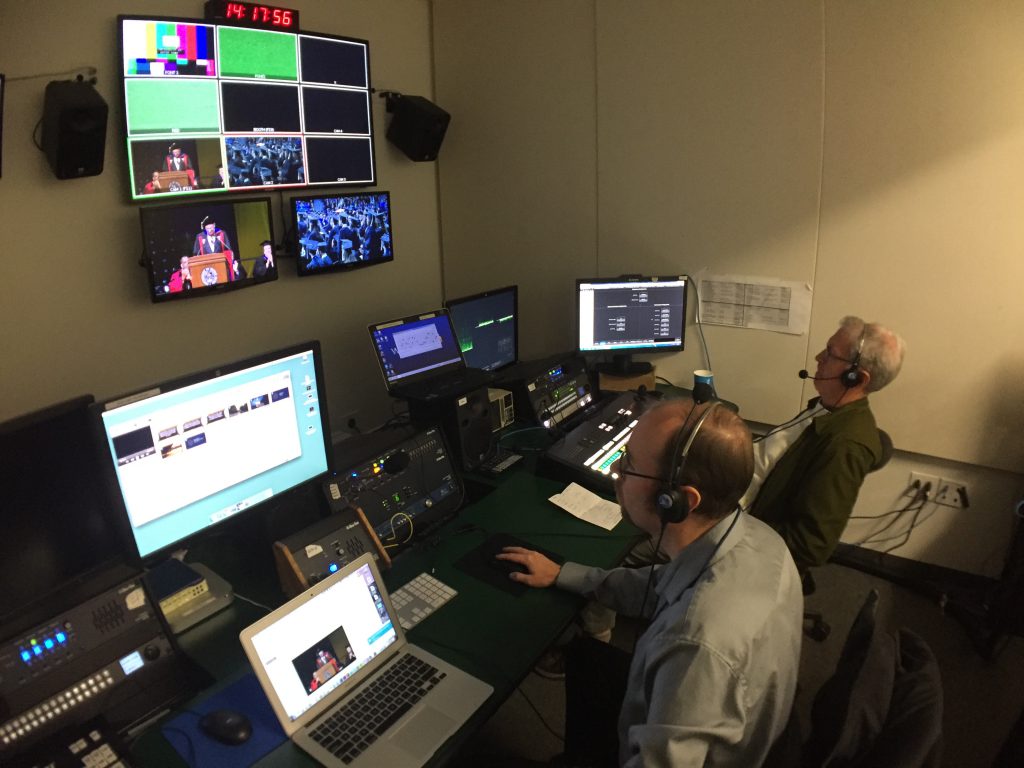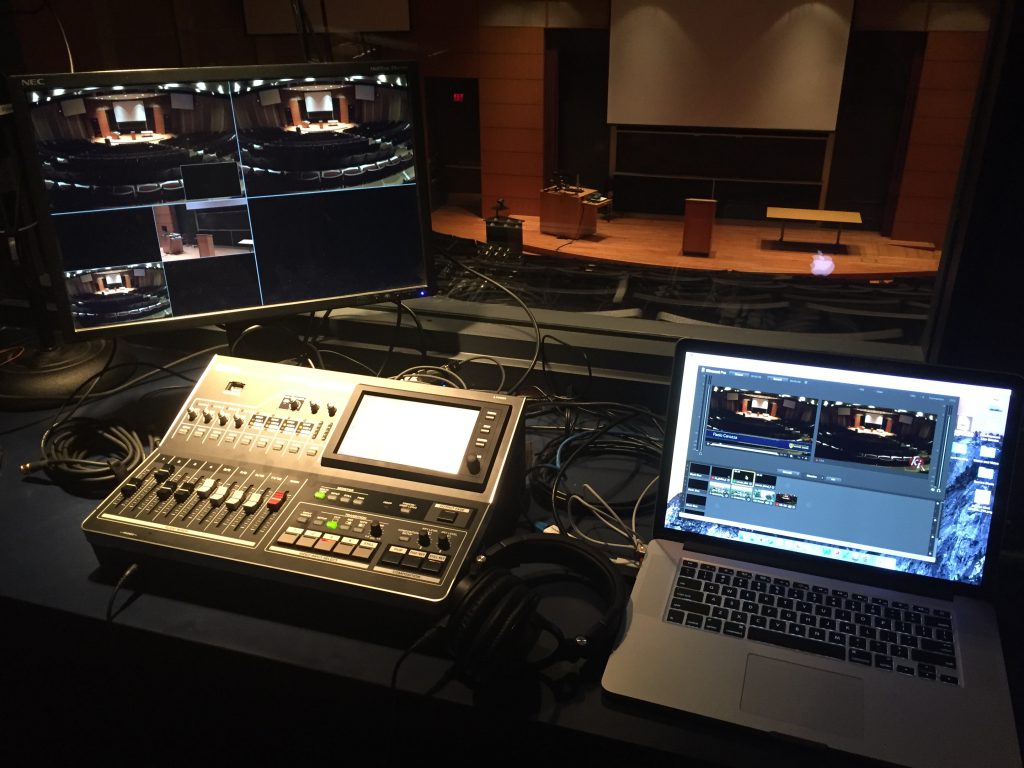 Notre Dame’s Eric Nisly guides live-streaming of commencement and other events using resources like this production truck.
Notre Dame’s Eric Nisly guides live-streaming of commencement and other events using resources like this production truck.
Live-streamed video takes you to the heart of an event and lets you share in its emotion from wherever you are.
Maybe a friend or family member is crossing the stage to get a diploma, or an ensemble of musicians is playing passionately to win a prestigious international prize, or a university is interviewing teachers and students during an online fundraiser to share with alumni the kind of moments that make the campus special.
These are just some of the hundreds of annual events now streamed by the University of Notre Dame. The volume of streamed events has roughly doubled in the last three years as the public’s appetite for streaming video grows.
Notre Dame’s production team, including Streaming Engineer Eric Nisly, have learned from experience a few best practices that make a big difference in keeping glitches low, emotional impact high, and results solid. We asked Eric to share 9 of his top tips.
- Get the word out
- Plan to fail
- Keep crew responsibilities narrow
- Get the two most wanted camera angles
- Ensure live support from your streaming platform
- Better than selling DVDs: stream goodwill
- Document success: crowdsource your streaming playbook
- Build strategic vendor relationships
- Keep raising the bar: put a point person on R&D
1. Get the word out
“In the months before commencement, every communication about the weekend, from emails to social posts, includes the URL ‘commencement.nd.edu’,” Eric says. The main page of the commencement site includes a link to the live stream.
People are grateful. Last year’s commencement broadcast, with about 20,000 gathering on campus, drew 4,200 unique viewers from all 50 states and 80 countries. “Many students have friends and family outside the US, and they tell us how happy they are that they can be part of the event from far away,” Eric says.
2. Plan to fail
The team plans redundancy at each point. “The reality of life is that things fail,” Eric says. After four years’ experience staging commencement broadcasts, the team now makes sure that each encoder has access to a network jack, for instance, so that the risk of a Wi-Fi connection can be avoided.
Redundancy is critical. To serve overflow crowds on campus, events are multicast over the local network to large screens at backup venues. Last year, some devices had difficulty decoding the multicast feed, so the secondary live stream, which was being sent out over the Internet, had to become the primary on-campus signal. It succeeded.
3. Keep crew responsibilities narrow
Each camera crew has a minimum of two people: a videographer to capture the event, and a streaming technician to manage the live stream connection. “If there’s a connection issue, we don’t want the videographer to have to troubleshoot,” Eric explains. “We need that video file.”
4. Get the two most-wanted camera angles
When diplomas are issued, the team prefers to use a minimum of two cameras. One is aimed at center stage to get a clean shot of the presenter and the hand-off, and the second is on the side where the recipient exits. A technical director switches back and forth between cameras. “Friends and family members want to see the emotion on a student’s face as they walk off, and you won’t get this quality with a single camera shoot,” Eric says.
From Notre Dame’s control room, a technical director can switch between cameras and events. Photo courtesy Eric Nisly
5. Ensure live support from your streaming platform
“The thing we like best about [IBM Watson Media] is that we have a phone number for first level support,” Eric says. “If the support person we reach on the phone says ‘we’re not seeing any packets at our end,’ then we know the problem is on our network, the sending end. If we didn’t have live support from our streaming platform, we wouldn’t have as quick a way to figure out where the trouble is.”
6. Better than selling DVDs: stream goodwill
Live streaming the commencement weekend has worked so well at Notre Dame that the university no longer feels the need to produce post-event DVDs and offer them for sale. “We’re posting the entire ceremony online so it’s available free,” Eric says. More people can watch afterwards, with greater convenience, building good will.
7. Document success: crowdsource your playbook
“We test and re-test everything in the weeks and days before each event,” Eric says. Equipment, connections and processes for each location are diagrammed in a Google Docs playbook that team members can access and update. “Everyone can see that a given event is sent to a certain channel for primary and another channel for secondary,” he says. Details like these have minimized errors. Playbooks are updated after each event.
8. Build strategic vendor relationships
It’s important to have relationships with video vendors that enable a team to demo equipment before purchase, Eric says. “We might find in advance that a certain component isn’t adequate,” he says. “Without a relationship, if there’s an issue with a component, we’d dump it. With a relationship, we can report a problem and help a vendor fix the problem in their system.” Close vendor communication has kept production quality high and has resulted in product improvements from some vendors, he adds.
9. Keep raising the bar: have a point person on R&D
“Each team should have someone who has the time and responsibility to be evaluating new products,” Eric says. “If they’re going to improve the quality of their streaming service, an important part of the job is R&D.”
Eric and his colleagues have been busy with R&D. Later this year, they’re introducing ND Studios, a collaborative media production and distribution organization and a new approach to video infrastructure. It includes fiber connectivity to event venues and a centralized control room with enterprise-grade encoders and routers. “The University chose cutting-edge technology that’s right up there with major networks,” Eric says. “It will be a significant change in the world of academia.”
With people from 80 countries watching commencement online, 8,000 viewers for the streamed Fischoff Ensemble Competition on campus, and $2 million raised in the latest online Notre Dame Day fundraising event, streaming video is already playing a large role in the quality of outcomes at Notre Dame.
Enterprise-grade encoders and routers will be part of the new ND Studios. Photo courtesy Eric Nisly
Start with a free trial of IBM’s video streaming services to see how you could achieve similar success.

